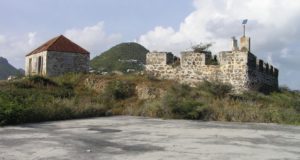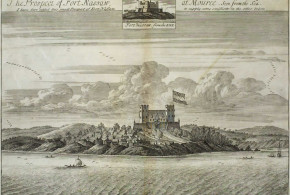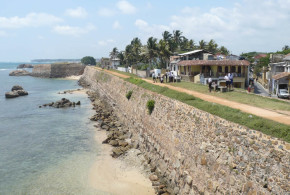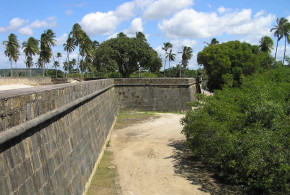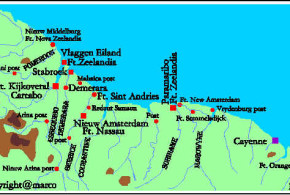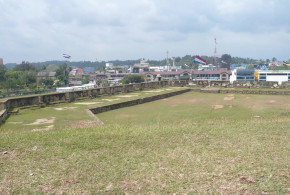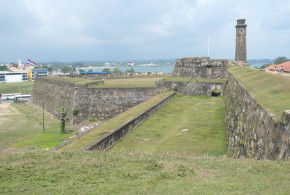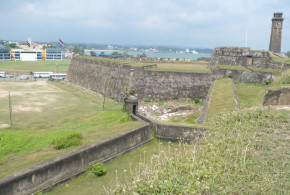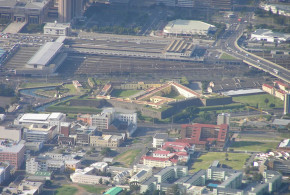This post is also available in:
![]() Português
Português
Written by Marco Ramerini. English text revision by Dietrich Köster.
Continued from: The arrival of the Danes, the Dutch and the construction of the Portuguese Fort
4.0 THE DUTCH CONQUEST AND THE ABANDONMENT OF THE FORT
The first attack of the Dutch on the Portuguese forts of Ceylon was directed towards the eastern coast of the island, where the Portuguese were less strong. Their first objective was the fort of Batticaloa.
On 9 April 1638 the Dutch commander Coster with three ships reached Batticaloa, on 10 May other five Dutch ships reached the place and on 14 May arrived also the troops of the king of Kandy, about 15,000 men. The fort was cannonaded and on 18 May 1638 after a poor resistance of four hours the garrison of the fort of Batticaloa was forced to surrender.1 During the Dutch attack approximately 700 persons had been sheltered in the fort, 50 of whom were Portuguese and Mestiços, the rest was formed by native inhabitants, which resided in the city near the fort, which was burnt shortly before the attack of the Dutch. All the Portuguese officials and soldiers were deported to the city under Portuguese control of Negapatam, situated on the Coromandel coast, whereas the Mestiços and the other inhabitants of Batticaloa were allowed to remain.2 After the conquest the Dutch left a garrison of 100 soldiers under the command of Willem Jacobsz Coster, who had been the commander of the Dutch troops during the siege.
In the wake of the obtained victory in Batticaloa and after some failed attempts, the Dutch headed by the admiral Westerwold succeeded in making the King of Kandy Rajasinha II sign a treaty of anti-Portuguese alliance. In such a treaty the Dutch engaged themselves to help Rajasinha II in his war against the Portuguese. In exchange they obtained the monopoly of the rich island commerce. In virtue of this treaty of alliance with Rajasinha, the Dutch attacked, supported by the troops of the kingdom of Kandy, the other Portuguese settlements along the coasts of the island.
The fort of Trincomalee was the second objective to fall in the hands of the Dutch. It was conquered after a short siege, during which, as narrated by Ribeiro, 23 soldiers of the Portuguese garrison were killed.3
In the description of the events the same Dutch commander Antonio Caen helps us with his diary, where he describes the preparations for the siege, the bombardments of the Portuguese fort and the surrender of the garrison.4 The fleet under the command of Antonio Caen was composed of 11 ships with on board 353 guns and 1,280 men, of which 325 were soldiers and the rest sailors.5 The Dutch ships arrived in the bay of Coutijar in the evening of the 18 April 1639 and here the Dutch met the governor of Samantura (Sammanture), who had arrived overland from Batticaloa. The following day the wanniya6 of Kottiyar paid a visit to the Dutch. He described in detail the defences of the fort and the composition of the garrison. According to the testimony of the wanniya the fort was of dimensions similar to those of Batticaloa and had three bastions. The bastion facing the land side was defended by six guns as well as that which controlled the bay, while on the bastion, which controlled the sea, two guns were mounted. All the guns were of iron and had been salvaged from a Danish ship, which turned into an abandoned shipwreck in the bay approximately twenty years before. The garrison was composed of 40 Portuguese, about 100 mestiços and blacks and finally about 30 casados with their families.
On 20 April a squad of Dutch soldiers, headed by vice commander Coster, made an inspection of the defence of the fort. During this inspection they succeeded in detecting some weak points. The next day, with two boats, one of these overturned, the north east side of the fort was explored. On 22 April about 60 soldiers disembarked for a closer inspection of the Portuguese fort. It was surveyed from a very close distance. On the other hand the Portuguese garrison made two gunshots as a warning.
On 23 April 163, early in the morning the Dutch disembarked 40 sailors and several soldiers, they began to clean up a road so as to render the transport of the artillery possible for a siege and chose a place suitable for the erection of a battery. While these works were well advanced, the Portuguese from the fort shot many gun and musket shots in order disturbing the works, then a group of 30 Blacks tried an escape, but they were driven back by the Dutch soldiers.
The following morning other sailors and soldiers disembarked. They began to work at the construction of some batteries. A new escape was tried by the Portuguese and during the skirmish, which followed, a Dutch was mortally wounded. The Dutch continued for all the day to work at the batteries. Furthermore some guns were disembarked from the ships and in the evening the construction of three casemates was practically finished.
On 25 April five soldiers of the garrison of the fort disembarked on a small boat in the vicinities of the Dutch works of entrenchment. This was followed by a short skirmish, in which a Dutch soldier was wounded, while on the Portuguese side a black was killed. In spite of this inconvenience in the evening the Dutch had finished the construction of 10 embrasures, 4 of which were already encircled by palisades. During the 26 April it was the first mutual exchange of artillery shots between the fort and the Dutch batteries. For the entire afternoon the Portuguese bombed the Dutch positions intensely, but, as Caen informs us in his diary, the cannon-balls were nearly all of stone and this denoted the lack of iron cannon-balls. The Dutch on their side bombed some defence works, which the Portuguese were feverishly building in the vicinities of the main entrance of the fort. The exchange of shots resulted in the wounding of two Dutchmen and the death of a Black. Subsequently other artillery was disembarked from the ships and put in the batteries by now nearly finished. In order to prevent every communication and aid from the sea to the besieged, two ships the ‘Ryswyck’ and the ‘Nachtegael’ were sent to garrison the side of the fort towards the sea. Also the following day the works incessantly continued, although the bombardment from the fort continued.
On 28 April before noon the ship ‘Cleyn Amsterdam’ with on board the ambassador Jacob Compostel arrived from Batticaloa. He reported the news that Rajasinha was involved in attacking the Portuguese in the environs of Colombo and could not come in aid of the Dutch. However, he informed Caen that he would soon send some mudaliyars7 a force of 4,000 soldiers to help him in the siege of Trincomalee. The Dutch troops suffered very much in consequence of the climate of the area and Caen informs us that many men died because of this fact. It was decided to increase the speed, so that all would be ready 1st May. In the afternoon of the 28 April Caen disembarked in order to verify the works made. The soldiers were organized in three companies composed of 70 soldiers each and besides this was formed a fourth company composed of soldiers and sailors. The troops were passed in review. On the following two days the works of the batteries were finished and all pieces of artillery were placed.
On 1st May 1639 an hour before dawn all the soldiers were disembarked. The Dutch decided to carry directly the main attack against the north bastion8 but in the meantime also the bastion “St. Cruz”, which was situated more to the west, was bombarded, to prevent the use of it by the Portuguese. The effect that the bombardment made on the defence of the fort was devastating. After an hour and a half of intense bombardment all the guns of the Portuguese fort were practically destroyed. The garrison could only fire musket-shots. After three hours of continued bombardment the blows had opened a large breach in the bastion ‘St. Jago’. Thus it was easily possible to enter through it into the inside of the fort. Caen decided that the time had arrived to send the lieutenant Blaauw with a drummer and a white flag to propose the Portuguese garrison the surrender in favourable terms, but the negotiators were received with artillery shots and they were forced to a hasty withdrawal. After this dishonourable behaviour of the Portuguese garrison the bombardment of the fort was resumed and it was decided after a council on board the ship ‘Armuyden’ the following morning to prepare for the attack of the bastion ‘St. Jago’ and the wall next to the bastion ‘Sancta Cruz’. In the resolution taken by the council the bastion ‘St. Jago’ was described as demolished for its greater part and all the guns were assumed to be out of service from 10 o’clock in the morning, since the moment when no more gun shots had been discharged from the fort. A detailed plan for the assault of the fort was also drafted, in which 514 men, among them soldiers and sailors, had to be involved.
While the preparations of the plans for the assault were well advanced, two Portuguese captains arrived from the fort with a white flag. They were sent by the captain of the fort to make excuses for the earlier reception reserved by some inexpert soldiers to the negotiator. Caen asked them to surrender, seen the miserable condition, to which the fort had been reduced by the Dutch artillery. But they refused resolutely, saying that inside the fort was a garrison of 300 Portuguese and that only a Black and a Kanarese had been killed by the bombardments. The Dutch commander determined then to put in custody the two men and to continue the preparations for the assault.
On 2 May at dawn, while the Dutch soldiers prepared themselves for the definitive assault, a priest and another person with a truce flag advanced from the fort. They declared that they were there to negotiate the surrender. In exchange the Portuguese asked for a free leave with their own goods and their own slaves. Moreover the Portuguese asked for being able to be followed by the fishermen (Careas)9, Caen agreed in part with their demands, but refused to accept that the fishermen followed the Portuguese. He also limited the choice of the places, where the Portuguese could move to Tranquebar and Nagapatnam preventing peremptorily their transfer to Jaffnapatnam or to any other place in Ceylon. The priest, after having received these assurances returned to the fort to report to the Portuguese commander the conditions of surrender. In the meantime the Dutch troops quickly drew up to assault the fort. The priest returned fast delivering the keys of the fort and declaring that the garrison accepted the surrender conditions. A company of Dutch soldiers entered the fort ordering —– the soldiers of the garrison to leave their own weapons within the fort and to enrol the name in a registry. The commander of the fort, Francisco Deça 10 together with his captains and the soldiers of the garrison waited for Caen and in sign of submission he delivered to the Dutch commander his gilded silver court-sword. Caen in sign of courtesy gave back to the Portuguese commander his court-sword. It was therefore on 2 May 1639, after some days of siege
11 that the short period of Portuguese occupation of Trincomalee came to an end.
The fort was found by the Dutch in poor condition, the guns, found on the bastions ‘St. Jago’ and ‘St. Cruz’, had been swept away and were buried under the ruins of the wall.12 According to the testimony of Caen two hours after the occupation of the fort reinforcements promised by Rajasinha arrived. They were about 3,000 combatants headed by two mudaliyars. Afterwards a ceremony of thanksgiving for the victory was held inside the Portuguese church. The Dutch losses were two death casualties and two wounded, while on the Portuguese side there were 11 fatal casualties among the Europeans, 1 mestiço and 2 Kanars and 9 wounded.13 After the conquest of the fort there were some episodes of violence concerning the Portuguese inhabitants. This led Caen to publishing a ‘placaat’ 14 where he menaced the hanging of those, who were guilty of such actions. These acts of atrocity were accomplished either by the Dutch or by the Singhalese.
According to the Dutch version the two mudaliyars with their troops arrived after the occupation of the fort and they immediately asked that the fort should be entrusted to their troops. The Dutch answered exhibiting the treaty signed with the king, in which it was clearly indicated that the captured forts had to be occupied by a Dutch garrison.15 That is why the Dutch felt themselves in the right to occupy the fort with a garrison of their own. As the commander of the garrison of the fort was left the fiscal Gerrit Herbers. The occupation by the Dutch of the fort of Trincomalee without the cession to the king’s troops, made the king of Kandy remarkably nervous. He strongly protested with the Dutch for not respecting his wish. He even installed a blockade of the supply shipments for the troops of the garrison of the fort, but later on he softened his position.
In the same year the Dutch reconstructed and reinforced the fort, but the following year (1640), as a result of an agreement with the Kandyans it was abandoned 16 and in exchange for 10 elephants ceded to the king of Kandy17. A few years later it was demolished (perhaps in 1643) by the Kandyans. In 1641 the fort of Batticaloa was also ceded to the Kandyans, who immediately demolished it. The reasons of this cession of the two forts to the king must be searched beyond the continuous demands of the king to the fact that the Dutch regarded the territories around the two forts as little profitable.18
The ports of the eastern coast, those of Trincomelee, Kottiyar and Batticaloa, were used during the period, in which they were under the control of the kingdom of Kandy, as ports of free commerce with the other Asiatic kingdoms and also with other European powers (mainly the English 19 and the Danish). This annoyed the Dutch much. Through the three ports the Kandyans traded rice, ivory, elephants, areca, honey, timber, clothes and other goods of first necessity. The port of Kottiyar in particular was intensely used by the Kandyans. They had in Kottiyar a customs house, which they maintained until 1668, the year, in which the Dutch reoccupied the area. After this occupation the custom house was transferred more inland, to Minneriya. A road, connected the highlands of Kandy with Matale and Kottiyar. Such road followed in great part the course of the Mahaveli Ganga. All this zone made use of the port of Kottiyar for the commerce with the exterior. A market, where the merchandise exchanges happened was implanted at Killevetty, a few miles from the coast. At Kottiyar a colony of Chetties also settled.
To be continued by: The new Dutch occupation and the reconstruction of the Fort
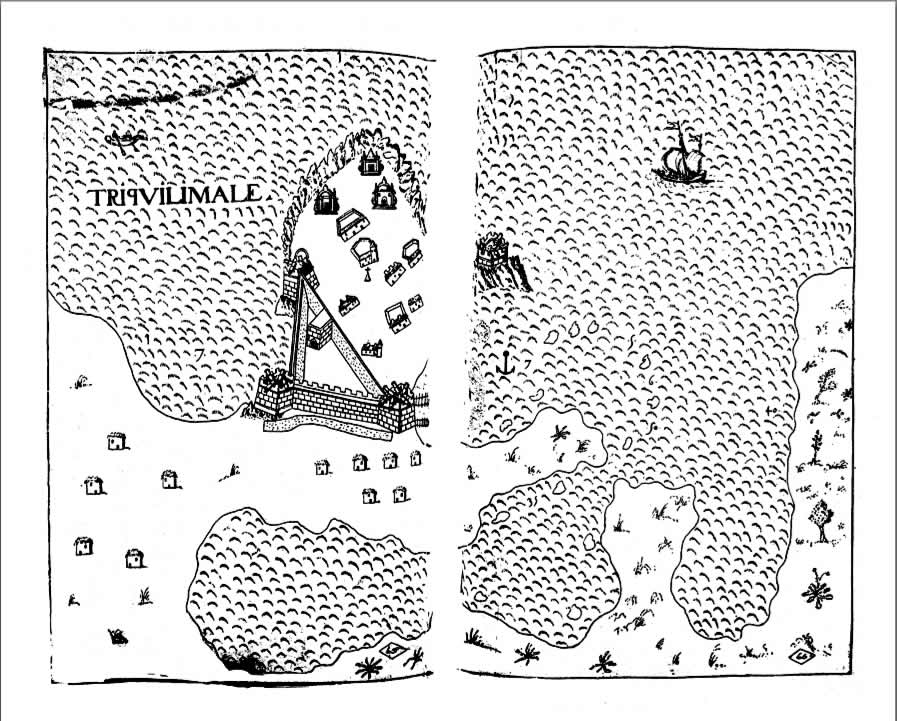
Map of Trincomalee by Antonio Bocarro (1635). Livro das Plantas de todas as fortalezas, cidades e povoaçoens do Estado da Índia Oriental (1635)
NOTES:
1 Goonewardena, p.17.
2 Theirs descendants, approximately 2.000 persons, still today speak a Creole Portuguese, and are Catholics.
3 Ribeiro “The historic tragedy of the island of Ceilão”, pp. 105-106.
4 In: J.R.A.S. (Ceylon) n°35 (1887) “The capture of Trincomalee A.D. 1639”, pp. 123-140.
5 The names of the ships were the following: “Utrecht”, “Henrietta Louisa” , “Egmont”, “’s-Hertogenbosch”, “Wassenaar”, “Der Veer”, “Armuyden”, “Valkenburgh”, “Reyneburch”, “Onderwater”, “Zeeuwsch Nachtigael”. In the Caen’s diary is indicated like a yacht flagship the ship “Armuyden”.
6 Hereditary head.
7 A military head.
8 Called by Caen “St. Jago” and according to the description of Bocarro it was called Sancto Antonio.
9 Chaste of Tamil fishermen.
10 Queyroz “The temporal and spiritual…”, vol. III, p. 817.
Francisco Deça was a ‘casado’ (a married man) of Colombo, he will soon return to Ceylon, because he is mentioned by Queyroz among the wounded of the battle of Caymel (Kammala) in December 1639 (in January 1640 according to Goonewardena “The foundation of Dutch power…” p. 31) against the Dutch. Queyroz “The temporal and spiritual…”, vol. III, p. 823.
11 Queyroz indicates the duration of the siege as 40 days of bombardment. But the diary of Caen clearly indicates that the Dutch reached Trincomalee on 18 April 1639 and the fort surrendered on 2 May 1639. Queyroz “The temporal and spiritual…”, vol. III, p. 817.
12 The poor state, to which the bastions of the fort were reduced, was also due to their weakness, being filled up with earth only. Ribeiro “The historic tragedy of the island of Ceilão”, p. 105.
13 This according to the diary of Caen, while according to Ribeiro the dead among the Portuguese were 23 on a total of 50 men of the entire garrison. Ribeiro “The historic tragedy of the island of Ceilão”, p. 105.
14 An ordinance.
15 In: J.R.A.S. (Ceylon) n°35 (1887) “The capture of Trincomalee A.D. 1639”, pp. 123-140, also in: Goonewardena, p. 28.
16 Queyroz “The temporal and spiritual…”, vol. III, p. 848.
17 Winius “Fatal history of Portuguese Ceylon”, pp. 43-44.
18 Goonewardena, p. 65 and nota 24 p. 77.
19 In 1659 reached Kottiyar an English ship on which Knox was boarded.
This post is also available in:
![]() Português
Português
 Colonial Voyage The website dedicated to the Colonial History
Colonial Voyage The website dedicated to the Colonial History














